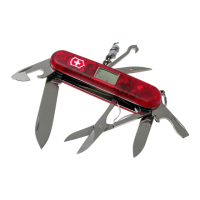November 5, 2015 5/10
Example 1 (Stnd)
You are at an altitude of 600 m above sea
level and measure a temperature of 13°C.
The standard temperature for this altitude is
11.1°C. As the temperature difference from
this standard value (13°C - 11.1°C = 1.9°C) is
in the range of ±5°C, the setting is left as
"Stnd" in the "weather correction mode".
Example 2 (Hot)
You are at an altitude of 600 m above sea
level and measure a temperature of 25°C.
The standard temperature for this altitude is
11.1°C. As the temperature difference from
this standard value (25°C - 11.1°C = 13.9°C)
is greater than 5°C, the setting must be
changed to "Hot" in the "weather correction
mode". The standard curve is adjusted
(shifted) and the altitude value is therefore
calculated more precisely.
Example 3 (Cold)
You are at an altitude of 600 m above sea
level and measure a temperature of 3°C. The
standard temperature for this altitude is
11.1°C. As the temperature difference from
this standard value (3°C - 11.1°C = -8.1°C) is
greater than 5°C, the setting must be
changed to "Cold" in the "weather correction
mode". The standard curve is adjusted
(shifted) and the altitude value is therefore
calculated more precisely.
Note
The altimeter can also be used as a barome-
ter (see description of the barometer).
Altitude rises > Air pressure drops > bad weather
Altitude falls > Air pressure rises > weather is improving

